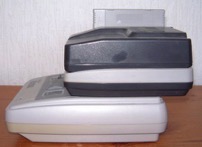
Background
The Multi Game Hunter (MGH) is a cartridge back-up device released by the Venus corporation. The system works by allowing you to dump the contents of a cartridge to floppy disk(s) or to load previously dumped cartridge images back into the onboard RAM of the device.
One unusual feature of the MGH is that it's compatible with both the SNES and the Megadrive. The only difference is the connector bridging the device to the host system.
There isn't a massive amount of information online detailing the MGH, but from what I can ascertain, there were two versions available - one in black and one in grey. Images of the grey system can be found on this page.
One website I've visited states that the grey model cannot be upgraded from its original 16 megabits of onboard RAM, while another website reports that the grey model can be upgraded, and it's the black version that can't.
I have tried to dismantle my MGH in an effort to discover whether it can or can't be upgraded, but as yet I have not been able to find any chips which look like RAM. The box that came with my MGH states that the grey version can be expanded, however.
The MGH is powered by a 9v external power supply which is not included. I’ve found that Megadrive, Genesis and Spectrum+2 supplies all work well well with the system.
The PSU supplies power to the floppy disk drive, and all other parts of the device will work without the PSU plugged in. This means that once you've loaded your desired game (games are loaded into the system's RAM in their entirety), you can disconnect the power supply if you so wish.
With regards to data storage, each disk can store up to 12 megabits (approx 1.536 megabytes) of data. For dumped cartridge images that take up more than 12 megabits the image is spanned across multiple disks, and the system prompts you to swap disks as and when required.
These days the Everdrive cartridge is a more convenient and practical way of running ROM images on original hardware, but for its time the MGH was a versatile and well designed piece of kit.
Hardware Photos

To the left of the cartridge you can see a small black flap. Flick this up and a slot is revealed which can accommodate Megadrive/Genesis carts.
The floppy drive itself is apparently removable, but I’ve not attempted to remove it from the system. It works, so I don't want to tamper with it!
The whole unit connects to the SNES using the standard cartridge port, and while it may look a little unwieldy from the photo, it does sit securely to the console.


Side views


Rear and bottom
MGH to SNES Connector
In the above "bottom" photo showing the underneath of the MGH you can also see the connector which connects the MGH to the Super Nintendo. This can be removed and replaced with an adapter to connect the MGH to a Megadrive/Genesis instead. I can only assume that a different connector is also required to connect the system to a US Super Nintendo.
To remove the connector from the MGH you need to squeeze on the clip (shown in the top photo to the right) and pull. The clips aren't made that well, and the one on my unit is almost ready to snap off. I've found that this doesn't have any impact on the reliability of the system.
Although the edge connector cartridge is sealed, standard screws have been used, so it's easy to open up the unit and take a look inside.
The bottom two photos to the right show the inside of the MGH to SNES adaptor. As you can see, there's are no components contained within. The cartridge merely maps to the pins on the SNES cartridge slot.
Measurements have been included in the PCB photos as I was once contacted by a fellow MGH owner who had the device, but not the MGH to SNES adaptor. He was looking to make the adaptor himself, and these photos were going to be used as a design and manufacturing guide.
If you require high resolution images to help you make your own MGH to SNES adaptor please let me know. Likewise, if you have an MGH to Megadrive adaptor I'd love to get some images of that to add to this section of the web site.


Front and rear of MGH to SNES connector
